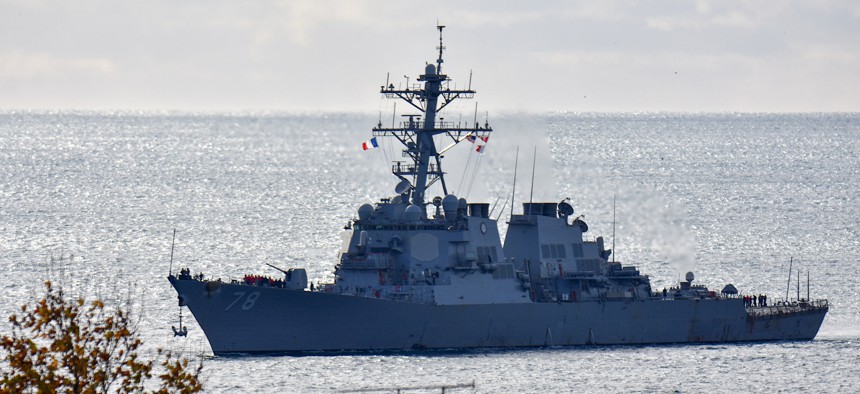
The USS Porter, an Arleigh Burke-class destroyer, arrives at the Old Port of Marseille in France, Dec. 5, 2021. Gerard Bottino/SOPA Images/LightRocket via Getty Images
Navy Shouldn't Build Next-Gen Destroyers Until Tech is Proven, Navy Secretary Signals
More testing needed on new tech “so that we don't get ahead of ourselves,” says Del Toro, citing mistakes made building the futuristic Zumwalt-class.
The Navy should consider buying Arleigh Burke-class destroyers until the technology it wants to install in its next-generation destroyers is ready for prime time, Secretary Carlos Del Toro said.
“Perhaps a better strategy might be to build a few more DDG Flight IIIs to ensure that we have the capacity necessary to deter China and do the other things that we need to do until such moment in time when” the DDG(X) and other new ships are ready, he said during the U.S. Navy Memorial’s SITREP event Tuesday.
Shipbuilders are eagerly waiting for the Navy to award an Arleigh Burke multi year contract, which they say will ensure the workforce is in place to build the DDG(X).
The future DDG(X) destroyer is expected to have the newest technology available, including lasers and sensors, which will require a new hull configuration to allow for more power than is available with the Arleigh Burke-class destroyers. But while it’s important to look at what requirements the Navy will have in the future, Del Toro said, it’s also crucial to make sure the technology is ready before the ships are built.
“We experiment, we do a lot of land-based testing on both their engineering plans and their weapon systems, as well … so that we don't get ahead of ourselves. And we actually start building them once we understand the capabilities that are going to go on them [and] the concept of operations for those ships as well too,” Del Toro said.
Del Toro mentioned the Advanced Gun System on the Zumwalt-class destroyer. The Navy made “some pretty broad leaps” in thinking the 155mm gun would eventually work, he said, but 20 years later, realized it would not. It fired projectiles so expensive (eventually costing about $800,000 each) that it is being replaced with vertical launch tubes for the Navy’s new hypersonic Conventional Prompt Strike missile.
The Navy’s next generation aircraft carrier, the USS Gerald R. Ford, has also struggled with new technologies, such as its electromagnetic catapults and weapons elevators.
Spending more to research and develop these new technologies may mean it will take longer for them to reach the fleet, Del Toro said.
“[We’ve] got to make sure that the technologies that we employ on these platforms actually work before we actually put them on there. A lot of that has to do with experimentation,” he said.




